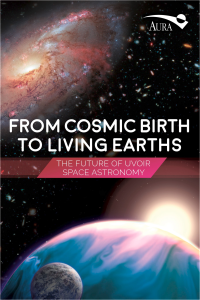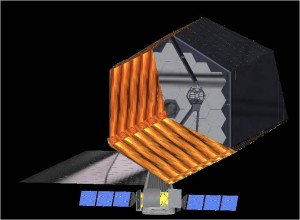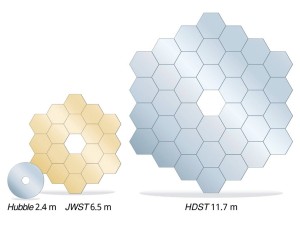Before the James Webb Space Telescope flies, enterprising astronomers are already proposing a High-Def spotter scope – a “super Hubble.”
The High-Definition Space Telescope (HDST) would view the universe with five times greater sharpness than Hubble can achieve, and as much as 100 times more sensitivity than Hubble to extraordinarily faint starlight.
Given those super-power attributes, the HDST could look for signs of life on an estimated several dozen Earth-like planets in our stellar neighborhood. It could provide the first observational evidence for life beyond Earth.
Those are among the views expressed in a new study issued by the Association of Universities for Research in Astronomy (AURA), based in Washington, D.C.
Giant aperture
AURA spearheaded the study of space-based options for ultraviolet (UV) and optical astronomy in the era following the James Webb Space Telescope’s mission, planned for launch in 2018.
Though the new report does not address a specific design for the HDST, its mirror would have to be at least 12 meters (39 feet) across to conduct a robust survey of nearby habitable planets.
To do so would require combining up to 54 mirror segments to form a giant aperture. The construction of the JSWT’s 18-mirror mosaic provides an important engineering pathway, the report notes, to demonstrating proof-of-concept for the HDST type of space observatory architecture.
Envisioned for the 2030s
“Though such a telescope is envisioned for the 2030s, it is not too early to start planning the science needs and technological requirements,” explains an AURA press statement.
The HDST would be located at the Sun-Earth Lagrange 2 point, a gravitationally stable “parking lot” in space located 1 million miles from Earth. It would house a suite of instruments — cameras, spectrographs, and a coronagraph — for blocking out a star’s blinding glare so that any dim, accompanying planets can be directly imaged.

HDST folded within an Evolved Expendable Launch Vehicle (EELV) or Space Launch System-1 shroud.
Credit: AURA
The construction of HDST would be modular so that astronauts or robots, could swap out instruments and other subsystems. “As with Hubble, this would ensure an operational lifetime spanning decades,” the AURA statement adds.
To access the full AURA report, go to:




